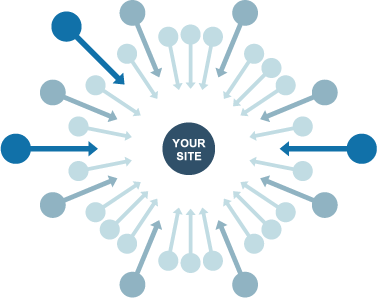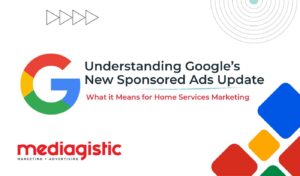
Is Google About to Drop a Penguin Bomb on Your Website?

A couple days ago, some eagle-eyed members of the SEO community (including our own local search strategist, Krystina Lisi) took notice of a post published on the Google Webmaster Central Blog. It was a fairly brief, yet significant reminder of the search engine giant’s policy toward large-scale article campaigns as they pertain to linkbuilding.
As an SEO strategy, acquiring quality backlinks through guest blogging outreach has long been a high-value proposition in terms of getting sites to rank in organic search results. But SEOs and Google have been engaged in a game of one-upmanship over various backlinking tactics for years now, and the rules have gotten stricter on a number of occasions. This raises questions about what Google may be planning to do with its Penguin filter in the coming weeks and months. As such, here’s a brief breakdown of what the post said, what it could mean, and what businesses need to do to prepare.
Just a Friendly Reminder About Your Backlinks…

For the most part, the Webmaster Central post itself is pretty straightforward. It says that, if sites are publishing a large amount of poor quality or duplicated content with the sole intent of acquiring keyword-rich backlinks, then that’s a violation of Google’s guidelines. This applies both to sites that are publishing articles containing outbound backlinks, and to sites that are publishing content with inbound backlinks on a large number of other sites.
In a nutshell, here are the guidelines that Google specifically laid out in this post:
“Below are factors that, when taken to an extreme, can indicate when an article is in violation of these guidelines:
- Stuffing keyword-rich links to your site in your articles
- Having the articles published across many different sites; alternatively, having a large number of articles on a few large, different sites
- Using or hiring article writers that aren’t knowledgeable about the topics they’re writing on
- Using the same or similar content across these articles; alternatively, duplicating the full content of articles found on your own site (in which case use of rel=”canonical”, in addition to rel=”nofollow”, is advised)
When Google detects that a website is publishing articles that contain spammy links, this may change Google’s perception of the quality of the site and could affect its ranking.”
Notice that Google makes it very clear that publishing violating backlinks “may change Google’s perception of the quality of the site and could affect its ranking.” Also of note, Google has qualified this statement by saying “when taken to an extreme.” While the first part should naturally raise concerns for publishers and businesses, it also means that Google will tend to focus on “extreme” cases as its first priority.
What Could this Mean for Publishers & Businesses?
What was curious about last Thursday’s post isn’t so much the content itself. Indeed, the post really contained no new information from what Google’s former web-spam czar, Matt Cutts, had said repeatedly back in 2013. So it’s interesting that the company would choose now to publish a seemingly random reminder of an ostensibly well-known SEO policy.
In an article published that very same day, Search Engine Land’s Danny Sullivan theorized that the post was a result of confusion that had arisen over Google’s backlinking policy. He also mentioned that representatives of SEL had spoken directly with Google at some point about several egregious cases of large scale linkbuilding that had been brought to the publication’s attention, and that this clarification could just be a natural response to those discussions.
However, another very distinct possibility exists here. Namely, when Google publishes something like this seemingly out of the blue, it more often than not means that something is about to change. And that most likely means the company’s dev team is going to be making some kind of update to the Google Penguin filter soon. If that’s the case, then now is the time for SEOs, publishers and businesses to take a good, long look at their sites’ inbound and outbound link profiles.
Getting Your Ducks in a Row: SEO Backlink Style
The last time Google updated Penguin, it was last September, when the filter was changed to run in real time within the core search algorithm. If Google is, indeed, going to overhaul its Penguin spam filter again (and some would say a change is due), then it’s advisable for SEOs, businesses and publishers alike to take stock of their backlinking practices. Here are a few things to look at when reviewing your inbound and outbound backlink profiles:
Inbound Link Profile
Your inbound link profile consists of all the offisite links that are pointing toward your site. Google considers each of these links to be a “form of endorsement,” so high-quality backlinks can send a lot of SEO juice to your site. If you’re doing any kind of blogger outreach with the intent of gaining backlinks for your website, these are the things to avoid:
- Exact Match Anchor Texts: An exact-match anchor text contains the exact key phrase you’re trying to rank for (i.e. for HVAC, it would be terms like “air conditioner repair” or “furnace installation”; for powersports, think terms like “sport motorcycle” and “jet ski”; for resorts, this would include terms like “all-inclusive Caribbean resort,” “Denver ski resorts,” etc.). Many sites already will have a lot of exact match anchor texts pointing to them naturally anyway, so you really want to aim for a robust backlink profile that includes longtail, branded, and natural key phrases. Any offsite SEO linkbuilding efforts should be mindful of your backlink footprint and reflect this goal.
- Private Blog Networks and Link Dumps: Private blog networks are large networks of sites that are being leveraged solely for building large-scale link campaigns. And link dumps are sites where pretty much anyone can log in and publish a piece of content without having to put that content through an editorial filter. These sites are incredibly dangerous from an SEO perspective, and their links are almost guaranteed to be toxic. There are many advanced ways to detect these sites, but you can avoid 90 percent of them if you ask these questions: Does the site look like a site someone would actually visit and use, or does it contain a lot of weird, unrelated content? Did your article have to go through any kind of editorial process? If you answered “no” to any of these questions, then it’s probably time to get that link disavowed.
- Duplicated Content Syndicated Across the Web: If you’re syndicating duplicated content — that is, if you’re just cutting and pasting the same content and posting it word-for-word all over the web without the appropriate markup (rel=”canonical,” etc) in hopes of getting “dofollow” links for your site — stop doing it! This is the very definition of spam. Google will sniff this out sooner or later, and your site will undoubtedly feel the full weight of the Penguin slap that it eventually will receive.
Remember that Google values links as “editorial votes” for your site. So, as long as the link is contained within an original piece of content that has been through an editorial filter, Google is likely to see this as a “good” link. Blogger outreach efforts, then, should be focused on high-quality websites that Google values as authoritative and which do not engage in blackhat or spammy behavior. Tools like Moz, ahrefs, SEM Rush, and Majestic can be used to identify high-value sites. And tools like ContactOut can be used to find the email address and phone numbers of bloggers and other influencers on social sites like Linkedin or Twitter for purposes of outreach.
Outbound Link Profile
Your outbound link profile consists of the links that are pointing from your site toward other sites on the web. Again, since Google sees each link as a “vote” for that site, it means that all of our outbound links signal an endorsement for that other site. Here’s what you should be looking at when evaluating your site’s outbound link profile:
- Site Authority and Quality: Are you linking to authoritative sites that offer a lot of deep research and quality information? Do people actually use this site, and does it consistently publish original content? If so, then you have nothing to worry about. If not, then you may want to consider removing the link or at least using the correct markup to ensure Google doesn’t count your link as a vote.
- NoFollow Tags: A rel=nofollow tag is a type of HTML markup that can added to any link on your website. This more or less tells Google to ignore the link, and it keeps you from passing your “vote” (as it were) to sites of suspect quality. A good rule of thumb is that — if you have any doubts about a site at all, but you still need to link to it for some reason — use a nofollow tag to play it safe. It’s only 12 characters of code, but consistent and judicious application of this tag can save lots of heartburn down the road.
- Guest Bloggers: Do you have a ton of people suddenly reaching out to you, asking to publish unsolicited articles or blogs on your site for free? If so, congratulations! Your site probably has attained a decent level of domain authority (Note: this is a controversial term; Google insists it doesn’t exist, but Moz says it does), which makes it a desirable target for linkbuilders. It’s important to note that not all linkbuilders are spammers or grey hat SEOs; indeed, when done correctly, the practices of guest blogging and blogger outreach are time-tested SEO tactics. But the content has to be valuable, authoritative, and able to pass some kind of editorial wall in order to get published. Bottom line: If you do decide to publish any guest blogging content, just make sure it passes those standards (or at least use a nofollow tag on all your outbound links).
As with all things SEO, these guidelines really just scratch the surface, but they should give you a good start to figuring out if you need to do something about your site’s inbound and outbound link profiles. Remember, ignoring some (or all) of these methods may actually work for you in the short-term; that’s how cheap backlinking companies stay in business. If you decide to ignore these best practices, though, then you’re doing so at your own risk and you’re definitely sacrificing the long-term viability of your site in favor of immediate gains. Eventually, you’ll run the risk of finding out too late how short-sighted and wasteful that decision may be.
Worried About Harmful or Toxic Backlinks? Mediagistic has You Covered
Of course, most business owners don’t know the first thing about SEO or how to evaluate backlink profiles. After all, you’re busy running your business, and it’s simply not realistic for you to know all the technical aspects of running a link toxicity report, and using it to disavow links and optimize your website. That’s why you hire SEO professionals and marketing agencies to handle these things for you.
At Mediagistic, we have a top-notch digital strategy team staffed by experts who know how to identify your website’s SEO issues and resolve them. In fact, evaluating a site’s link profile is among the first things we do whenever we start talking to clients about creating an online marketing plan for their needs. If you’re concerned about your backlink profile and any upcoming changes to the Google algorithm, give us a call today so we can get started on figuring out what issues your website might have.
Eddie Childs is the Inbound Marketing Manager for Mediagistic. His writing has been published by a range of websites and publications including Copypress.com, Jambase.com, NFLSoup.com, FootballNation.com, and Boating World, KnowAtlanta, Men’s Book, Cobb in Focus, TCL, Blush, Charged Electric Vehicles, Business to Business, and Catalyst magazines. Follow him on Twitter and connect with him on Linkedin.
Images via Thinkstock and Wikimedia Commons
You May Also Like

Mediagistic Announces Strategic Partnership with EGIA to Deliver Enhanced Marketing Solutions for Home Services Contractors
November 10, 2025Tampa, FL – Mediagistic, a full-service marketing and advertising agency specializing in contractors and service-based businesses, today announced a strategic partnership with… Continue Reading Mediagistic Announces Strategic Partnership with EGIA to Deliver Enhanced Marketing Solutions for Home Services Contractors…

Understanding Google’s Sponsored Results Update: What it Means for Home Services Marketing
October 20, 2025Google is once again reshaping how paid ads appear in search results, and this change (called the Google Sponsored Results Update) could… Continue Reading Understanding Google’s Sponsored Results Update: What it Means for Home Services Marketing…

Are OTT Ads Served on TV Superior to CTV Ads on Mobile Devices?
September 23, 2025As streaming continues to dominate the media landscape, advertisers face a critical question: where should their OTT ad dollars go, connected TV… Continue Reading Are OTT Ads Served on TV Superior to CTV Ads on Mobile Devices?…